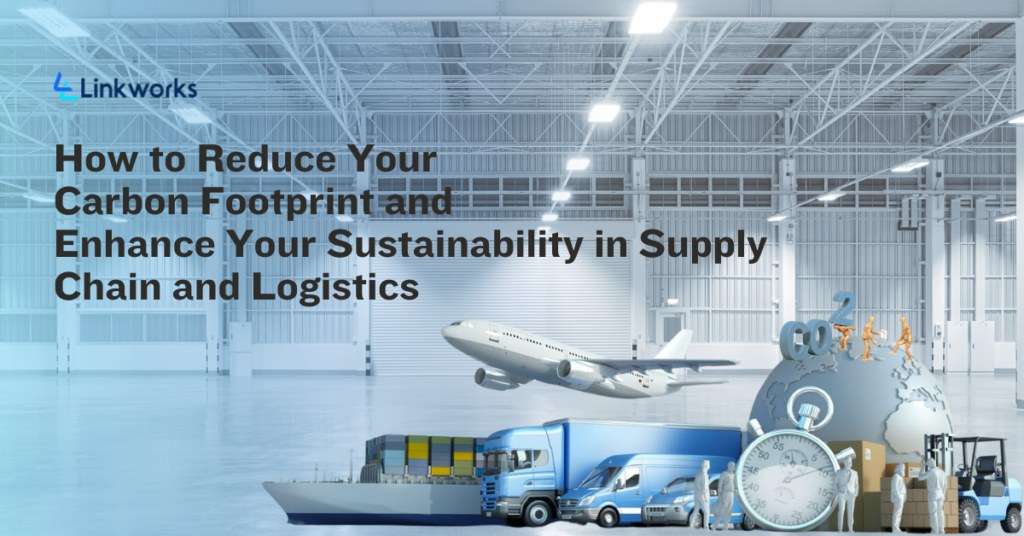
Introduction
In an era where environmental sustainability has become a non-negotiable priority, businesses across the globe are awakening to the critical role they play in shaping a greener future. Nowhere is this more apparent than in the realm of supply chain and logistics, where the intricate web of transportation, warehousing, and distribution can either exacerbate or alleviate our environmental challenges.
The carbon footprint associated with manufacturing and transportation to distribution and beyond, every link in the supply chain offers an opportunity to minimize environmental impact. Fortunately, this challenge also presents a unique opportunity for businesses to proactively contribute to environmental conservation while simultaneously enhancing their operational efficiency.
In this blog, we’ll explore practical strategies to not only shrink your environmental impact but also enhance sustainability across the supply chain.
Understanding Carbon Footprint in Supply Chain and Logistics
The carbon footprint of a supply chain refers to the total greenhouse gas emissions caused directly and indirectly by an organization’s logistical operations. It includes emissions from transportation, warehousing, packaging, and waste disposal.
Assessing Your Current Carbon Footprint
Quantifying and Identifying Emission Sources
To effectively reduce your carbon footprint in supply chain and logistics, begin by quantifying both direct and indirect emissions, encompassing operations, transportation, and third-party manufacturing.
Analyze fuel consumption and energy usage, pinpointing areas for improvement, like adopting fuel-efficient vehicles and energy-saving technologies. Further, identify high-impact activities, such as inefficient transportation routes and excessive packaging, to strategically target for carbon reduction. This systematic approach enables businesses to take informed steps toward sustainability, fostering environmental responsibility while optimizing supply chain efficiency.
Evaluating Supply Chain Partners and Practices
Assessing the environmental performance of your supply chain partners and practices is essential for reducing your carbon footprint.
Engage with suppliers and Vendors who share your commitment to sustainability. Assess their practices, and work together to find eco-friendly alternatives. By fostering a collaborative approach, you can create a network of like-minded partners dedicated to reducing the collective carbon footprint.
Reviewing Transportation Modes and Efficiency by Identifying opportunities to switch from high-emission transport, such as air freight, to more sustainable options like rail or sea freight. Optimize transportation routes to minimize emissions and maximize efficiency.
Evaluating Warehouse and Storage Practices by Looking for opportunities to optimize space utilization, reduce energy consumption through efficient lighting and heating systems, and implement waste reduction and recycling programs.
Strategies for Reducing Carbon Footprint
Optimize Transportation
Transportation is often the largest contributor to a supply chain’s carbon footprint. So, start by reevaluating your transportation methods. Opt for fuel-efficient vehicles, consider hybrid or electric options, and explore alternative fuels.
Utilize intermodal transportation, such as combining rail and trucking, to reduce long-haul trucking emissions. Additionally, focus on implementing sustainable last-mile delivery methods, such as bicycle or electric vehicle delivery in urban areas.
Setting a more strategic approach to route planning can significantly cut down emissions. Utilize advanced technology to optimize delivery routes, minimizing travel distances and reducing fuel consumption.
Energy-Efficient Warehousing
Transforming warehouses into energy-efficient spaces is a critical step. Warehousing and distribution centers are key areas where emissions can be reduced.
Switch to energy-efficient lighting systems and invest in energy-saving equipment. Consider motion sensors, renewable energy sources such as solar panels, and automated systems to optimize energy usage and minimize waste.
Prioritizing Waste Reduction and Recycling Programs to minimize the environmental impact of warehouse operations. Encourage employees to segregate and recycle waste, and work with suppliers who use eco-friendly packaging materials.
As a result, optimizing warehouse layouts can streamline operations, reducing the need for excess energy consumption.
Sustainable Packaging
Packaging contributes significantly to carbon footprints. Opt for materials with renewable resources, biodegradability, or recycling potential. Consider implementing innovative packaging solutions like reusable containers or minimalistic designs to reduce waste and environmental impact.
Embracing Green Technologies and Innovations
Technology and innovation play a crucial role in enhancing sustainability in supply chain management. By leveraging technologies like the Internet of Things (IoT) and smart devices, businesses can track and monitor their energy usage, emissions, and overall supply chain performance. This data provides valuable insights for optimizing operations and reducing environmental impact.
Data analytics enables informed decision-making and optimization, helping businesses identify areas of improvement such as optimizing transportation routes or reducing excess inventory. Integration of renewable energy sources, such as solar or wind power, into supply chain operations further enhances sustainability efforts.
Employee Education and Engagement
Encouraging employees and partners to embrace sustainable practices requires an integrated and collaborative approach.
Businesses can start by providing comprehensive training and education programs on sustainable practices in the supply chain. Raising awareness about carbon emissions, waste reduction, and energy conservation helps employees understand the importance of sustainability and empowers them to take ownership of sustainability initiatives.
Conclusion
Reducing your carbon footprint in supply chain and logistics is not only a responsible business practice but also a crucial step towards building a more sustainable future. By embracing eco-friendly transportation, optimizing routes, adopting green packaging, and collaborating with like-minded partners, you can contribute to a more environmentally conscious industry. Remember, the key lies in a holistic approach, where every aspect of the supply chain is considered and improved upon for a greener, more sustainable tomorrow.
Remember, every step towards sustainability counts. Make a difference by starting small and thinking large!
